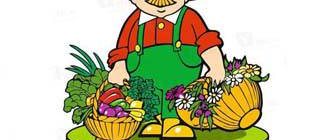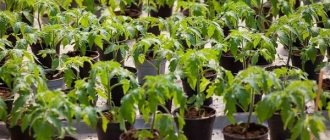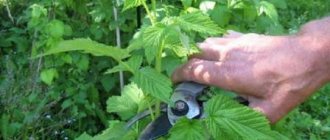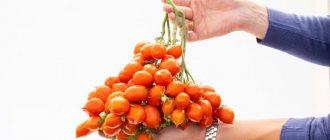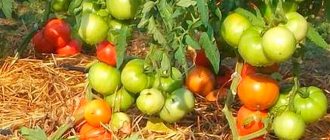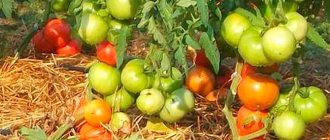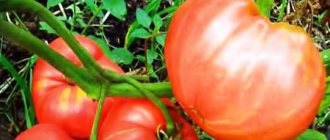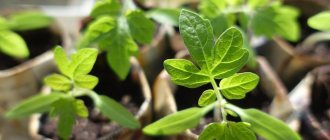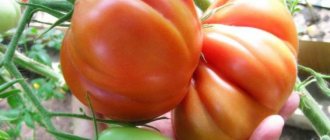“Geranium Kiss” or “Geranium Kiss” is a rare, collectible cherry variety that attracts gardeners with delicious tomatoes growing on clusters. Let's learn more about this unusual variety, why it is unique, how to plant it, grow it, collect it and preserve it - further.
Tomato seeds “Geranium Kiss”
Geranium Kiss tomatoes on a branch
Size of Geranium Keys fruits
Description of the variety
“Geranium Kiss” is unique due to its unusual combination of characteristics of the plant and its fruit:
- Bushes. Compact, dense, low growing, well leafy and highly branched. The plant is not a standard type, but a bush type. The stem is moderately thick. Height – 50-60 cm. The central shoot is able to support the weight of the fruit without additional support.
- Leaves. Strongly corrugated, green, oblong, with blunt teeth along the edges. The cuttings are thick.
- Inflorescences. Complex, lush. The flowers are lemon yellow. During flowering, the bushes are strewn with flowers. One inflorescence contains 50-100 flowers. Not all flowers develop ovaries and fruits.
- Fruit. 3-4 fruit clusters or more are formed. They look like grapes. Each fruit in such clusters weighs 20-40 g. The shape of the fruit is oval-round, with an elongated “spout” at the end. When ripe, the green fruits acquire a bright red color. The skin is dense, with a glossy sheen. There are few seeds inside the fruit.
The weight of the fruits on the clusters depends on their number - the more tomatoes in the bunch, the smaller they are, and vice versa.
The clusters of ripe tomatoes vaguely resemble the flowers of bright red geraniums - hence the unusual name.
Characteristics and productivity
Tomato “Geranium Kiss” is determinate. The variety is relatively new and little known among gardeners. Table 1 shows the main varietal characteristics.
Table 1
| Characteristics | Description/meaning |
| Ripening time | early ripening variety, from germination to fruiting – 90-95 days |
| Pollination | self-pollinating |
| Number of fruits per cluster | 90-110 pieces |
| Fruit weight | 20-40 g |
| Weight of fruit cluster | 500-1000 g |
| Taste | the pulp is sweet and sour, juicy, dense, tender, aromatic; sweetness predominates in the taste; tastes like cherry |
| Resistance to temperature anomalies | blooms and produces ovaries at temperatures above +30°C |
| Stepsoning | not required |
| Purpose | universal – for salads, pickling, canning |
| Productivity | unstable, depends on growing conditions (on average 2-3 kg are collected per bush) |
| Transportability | high, thanks to the strong skin and dense pulp |
| Resistance to diseases and pests | medium (can suffer from late blight, are affected by whitefly and spider mites) |
The variety has a variety - “Little Geranium Kiss” or Little Geraniums Kiss Tomato. It differs from its “big brother” only in size – it grows up to 30 cm in height. These babies are ideal for growing on balconies.
Possible diseases and pests, ways to get rid of them
Tomato Geranium Kiss variety description, photo is recommended as a crop with particularly strong immunity. Under conditions of optimal humidity, tomatoes perfectly resist bacterial and viral garden infections.
Fungal spores infect plants only when the greenhouse is overwatered or not ventilated. Weakened Geranium Kiss tomatoes can be affected by late blight and cladosporiosis. But usually an early ripening variety manages to produce a harvest before the season of fungal infections.
Disease prevention includes the following techniques:
- pre-planting treatment of seed material with fungicides;
- annual replacement of the top layer of soil in the greenhouse;
- removing lower leaves and weeding;
- compliance with crop rotation;
- preventive treatment of plantings with Bordeaux mixture (5%).
If infection of the Geranium Kiss cannot be avoided, the plants are treated with HOM, Barrier or Fitolavin.
Pests that can cause damage to tomato bushes are aphids, wireworms, Colorado potato beetles, and whiteflies. To destroy each species, select a separate drug or use universal insecticides Aktara, Konfidor, Iskra.
Advantages and disadvantages
Pros:
- Suitable for growing in any region.
- Simple agricultural technology.
- Grows well in open and closed ground.
- You can provide yourself with seeds yourself, since “Geranium Kiss” is not a hybrid.
- Within the cluster, the fruits ripen almost simultaneously.
- No installation of supports or trellises is required - no need to tie up bushes.
- There is no need to waste time pinching bushes.
- Resistant to cracking and blossom end rot.
- The bushes are decorative during flowering and fruiting - they decorate plots, balconies, and greenhouses.
Minuses:
- Despite early ripeness, not all brushes have time to ripen.
- In extreme heat, green “shoulders” form on the fruits. But they are not hard and do not spoil the taste.
- Does not tolerate high humidity well.
How to choose seedlings?
If you were unable to grow seedlings yourself, you can buy them. But in order not to be disappointed with the result, it is important to choose the right planting material.
Rules for choosing seedlings:
- Take seedlings that are strong, with intact roots.
- The first flowers should appear on the seedlings. If there are no flowers on the seedlings yet, this indicates that they are not ready for planting. If seedlings are planted too early, they will lag behind in development or stop growing altogether.
Soil preparation
The “Geranium Kiss” variety loves fertile and loose soils no less than other tomatoes. Recommendations:
- The soil should be neutral or slightly acidic, pH level no more than 7.
- If the soils are poor and infertile, they must be fertilized with humus and peat. It is also useful to add river sand.
- It is better to grow tomatoes in areas where pumpkins, zucchini, and cabbage grew. The worst predecessors are all nightshade crops. If potatoes, tomatoes, peppers or eggplants grew on the site, it is not suitable for “Geranium Kiss”.
- If the soils are fertile, you should not apply a lot of fertilizers - they are not needed at the beginning of the growing season.
The soil for growing seedlings must be disinfected: frozen or treated with potassium permanganate. Steaming for 45 minutes is also recommended.
Transplantation technique
The optimal time for transplanting plants into an open bed is the end of May, into a greenhouse - the first ten days of May.
10 days before transplanting, the seedlings are accustomed to fresh air - they are taken outside every day and kept in a well-lit place by the sun for 2-3 hours.
A day before the transplant, she is left to spend the night on the street.
Preparing the site
Tomatoes love to grow in a sunny place, where there is no stagnant water or strong winds. They prefer loamy or sandy loam soil, flavored with organic matter and mineral fertilizers.
The soil is prepared in the fall - it is sprinkled with humus or compost (10 kg), wood ash (3 kg), superphosphate and potassium salt (100 g each) per 1 m². After this, digging and leveling with a rake are carried out.
Autumn digging is carried out without loosening, in blocks. If you loosen the soil in the fall, it will become compacted over the winter and will have to be dug up again in the spring.
In early spring, the soil must be disinfected - it is sprayed with a urea solution (150 g per 10 liters of water).
Planting scheme
This plant has a compact shape and short stature, so the optimal planting pattern is 40x50 cm. The maximum number of bushes per 1 m² bed is 6-7 pieces.
Dig out the holes, pour water with the addition of a complex solution of nitrophoska (1 tbsp per bucket of water). Consumption per hole - 0.5 l.
When the moisture is absorbed, the bushes are planted, the roots are sprinkled with soil without fertilizers and hilled up to provide them with stability and to avoid rapid drying out of the soil.
Growing seedlings
The variety can be sown directly in open ground, or you can grow seedlings yourself. The second option allows you to speed up the harvest. You can buy seedlings, but then there is no guarantee that they grew in favorable conditions - this will affect the future harvest.
How to prepare seeds?
If the seeds are purchased from a reliable source, they are not only a reliable carrier of varietal qualities, but are also completely ready for planting. They are treated and have undergone all the necessary pre-sowing treatment. Soaking them is contraindicated. Store-bought seeds cannot be kept in either water or stimulants - the protective shell created by nutrients as a result of special processing will be damaged.
Tomato seeds harvested on your own - collected from fruits - have to be prepared for sowing:
- Keep in boiled water (40°C) for 3 hours.
- Immersion in a solution of potassium permanganate (1 g diluted in 100 ml) for 15 minutes. The seeds are saturated with potassium and manganese - these elements stimulate growth.
- Germination of seeds. They can be sprouted, for example, on toilet paper. Some gardeners use cotton pads for germination. The main thing is not to overcook the seeds. They should barely “hatch”. The sprouts should not be allowed to turn into long white threads.
Where to sow the seeds and where to place the crops?
Swollen or germinated seeds are sown in any suitable container - a pre-prepared nutritious soil mixture is poured into it. Regular plastic boxes, containers, disposable cups, wooden boxes are suitable, you can also buy special cassettes.
To make the seeds germinate faster, they are placed in a warm place. After germination, the crops are placed closer to the sun. You can grow seedlings in the house - on the windowsill, or in a greenhouse - if you have one.
Sowing seeds for seedlings
Sequencing:
- The substrate in containers or boxes is watered. There shouldn't be too much water.
- Furrows are made in moist soil. If sowing is done in glasses, make small indentations. Depth – up to 1 cm.
- In large containers, seeds are sown according to a 2x3 cm pattern, in small containers - 2x2 cm.
- The seeds are placed in the holes. If the seeds are sprouted - with sprouts, use tweezers. If you take the seeds with your hands, there is a high probability of breaking the fragile sprouts.
- The seeds placed in the soil are sprinkled with earth. And the container itself is covered with film.
Seedling care
Features of crop care:
- When shoots appear, the film is removed.
- Avoid overmoistening and stagnation of water.
- The grown seedlings are transplanted into separate glasses.
- Before planting in the ground, the seedlings are fed twice with a weak solution of mineral fertilizers.
- Before planting, the seedlings are hardened off - taken out into fresh air for a short time.
Read more about feeding seedlings.
Planting seedlings in the ground
If seedlings are planted not under cover, but directly in open ground, then temperature conditions are extremely important. At night, the thermometer should not fall below +15°C. And yet, even if the weather is warm, you should prepare a film according to the size of the area, just in case. If it gets colder, you need to immediately tighten the film.
The best time to plant seedlings is after 14-00. As soon as the first flowers appear, the plants are ready for transplanting.
Procedure for transplanting seedlings:
- 3 days before planting, stop watering the seedlings.
- Holes for planting are prepared on the site. For 1 sq. m there are 4 recesses. The depth of the holes is greater than the height of the container in which the seedlings grew.
- Pour 1 tbsp into each well. l. superphosphate and substrate for tomatoes.
- Pour water into the hole. When it is absorbed, water is poured twice more - the soil should be well charged with moisture.
- The seedlings are placed in the depressions, being careful not to damage the roots, and sprinkled with soil.
- Water with warm water. The next watering is after 7 days.
Planting seedlings in a permanent place
Relocation of seedlings to beds is usually carried out in the second half of May, when the threat of frost has passed and the ground has warmed up to 15°. However, you should keep the protective film on hand in case of a sudden cold snap.
By the time they are placed in open ground, the first flowers have already appeared on the seedlings, so it is better not to delay the planting process too much so that the plant develops properly and bears fruit. The growing area should be sunny and protected from strong winds.
It is better to start planting seedlings in the afternoon.
The transplant includes the following steps:
- Stop watering three days in advance.
- In the selected area, holes are made at the rate of 4–5 bushes per 1 m² with a distance between rows of 40–45 cm and a width between bushes of 30–35 cm.
- The depth of the holes is about 10 cm.
- The bottom of the holes is well loosened for faster rooting of bush growth.
- It is recommended to mulch the soil to prevent weeds and preserve moisture by digging in straw, sawdust, and compost.
- Fertilizer is applied to the hole, then warm water with a drop of potassium permanganate is poured.
- The seedlings are deepened and covered with soil, irrigated again with water and left until the next watering.
Growing tomatoes in open ground
In the south, tomatoes can be sown in the ground. But usually gardeners, even in the south, use the seedling method as the most promising. Let's learn how to grow Geranium Kiss tomatoes by sowing seeds in open ground.
Growing conditions
In regions with short summers, there is no point in sowing seeds directly into the ground; they simply will not have time to ripen before frost. In such an area, you only need to sow tomatoes in greenhouses. But in the south, sowing can begin in the spring, as soon as the soil warms up.
For growing tomatoes, sunny areas are allocated, covered on the north side - to protect the plantings from piercing cold winds. Fences, house walls, bushes, etc. can serve as protection. The area for planting tomatoes will be fertilized with humus.
In a greenhouse, tomatoes feel better, grow faster, and yield earlier. But plants grown in the open air are stronger, stronger, healthier, and the fruits are tastier than their greenhouse counterparts.
Planting seeds in open ground
Seeds are sown in open ground no earlier than April - the ground should warm up to 13-15°C. There is no clear opinion as to whether seeds planted in the ground need soaking. Proponents of the treatment dip the seeds in fungicides and growth promoters, just as they would in preparation for growing seedlings. Both solutions have their advantages and disadvantages.
Dry seeds are safer. If a cold snap hits, nothing will happen to them. After sowing, they do not sprout for about ten days. Sprouted grain sprouts already on the 4-5th day. In addition, sprouted seeds are planted in warm soil, and if the temperature drops, they will disappear.
Sowing order:
- The soil is loosened - it should be lush and soft. If the soil has not been fertilized since the fall, this is done in the spring. Humus is added; if the soil is dense, it is loosened by adding peat, sawdust or sand. The soil along with the fertilizer is dug up.
- A nutrient substrate is prepared and added to each well.
- Make small indentations - 1-1.5 cm deep. Layout - 30 x 50 or 40 x 60 cm.
- The depressions are watered. A weak solution of potassium permanganate would also be useful.
- Place 3-4 seeds in one hole. Sprinkle with a thin layer of soil and compact. There is no need to water - the soil is already moistened.
- When 3-4 leaves appear, in each hole the strongest one is selected from the sprouts that have emerged - the others are pulled out. They can be thrown away or planted elsewhere.
How to water?
Features of watering "Geranium Kiss":
- The beds are not watered until germination. Otherwise, the top layer of soil will become hard and it will be difficult for the sprouts to germinate.
- Ideal water is rain. It should be warm, approximately +22-24°C.
- Water the seedlings in the morning, while there is no sun, or in the evening.
- The frequency of watering before flowering is once every 7 days. Flowering plants are watered twice as often. In summer, the frequency of watering depends on the amount of precipitation.
- Water is poured at the root; water should not fall on the above-ground parts of the plants. Drip irrigation is preferable - it allows you to maintain the required level of soil moisture.
Loosening
“Geranium Kiss”, like any tomatoes, requires regular weeding and loosening. If you neglect this measure, the roots of the tomatoes will not receive enough oxygen and water - the dry crust of the earth prevents their access.
Loosening features:
- The first loosening is carried out after all shoots have appeared.
- The frequency of loosening is once every 14 days.
- Along with loosening, growing weeds are removed by the roots. Weeds not only interfere with the normal development of tomatoes, but also provoke various diseases.
It is recommended to mulch the soil - hay, straw, freshly cut grass. Mulch protects roots from overheating, prevents weed growth and retains moisture in the soil. Read more about soil mulching here.
Do I need to tie it up and pin it?
The “Geranium Kiss” variety is low-growing, so caring for it is simple - in the open ground they do not require tying up or cutting off the stepsons. But the leaves in the lower part of the bush must be removed - during the formation of fruits. Improved air circulation helps prevent illness.
In greenhouses, Geranium Kiss bushes grow up to one and a half meters in height - they are tied to supports.
Fertilizing
The roots of “Geranium Kiss” tomatoes grow up to 0.5 m deep, but they spread out to the sides over the entire area of the bed - so fertilizer is poured over its entire surface.
Features of fertilizing:
- Fertilizing is applied once every 10 days.
- Nitrogen is required during green mass growth.
- During flowering and when fruits ripen, plants need potassium.
The ratio of elements for feeding tomatoes “Geranium Kiss”: N: K:P – 1:1.8:0.5. Tomatoes also need zinc, copper, iron, boron, magnesium, calcium - plants receive them as part of complex fertilizers.
Diseases and pests
“Geranium Kiss” has excellent immunity. The variety ripens early, managing to complete fruiting before the main tomato diseases begin to rage. “Geranium Kiss” avoids the most serious diseases; the variety practically does not suffer from late blight, fusarium, powdery mildew, or verticillium. But the variety has no immunity against bacterial diseases.
Disease prevention:
- seed treatment with fungicides;
- using only healthy seedlings;
- in the greenhouse - update the soil every year;
- removing weeds and tearing off lower leaves;
- observe crop rotation - you cannot plant tomatoes in one area for more than 4 years;
- It is not recommended to plant tomatoes near nightshades;
- preventive spraying of plants with 5% copper sulfate.
If a bacterial disease cannot be avoided, the plants are sprayed with Fitolavin-300 and copper-containing fungicides. Against fungal diseases, plants and soil are treated with “Hom”, “Barrier”, and Bordeaux mixture.
The main enemies of any tomatoes are mole crickets, aphids, Colorado potato beetles, wireworms, and whiteflies. The insecticide is selected according to the type of insect. Affected plants are sprayed with “Confidor”, “Commander”, “Iskra Bio”.
Sowing dates and seedling care
You need to sow Kiss geranium seedlings 55-65 days before planting in the garden. This period takes into account 5-10 days for the emergence of seedlings. Taking into account the recommendations for growing this tomato, depending on the region, planting should take place in early or mid-May. For greenhouses in the south - from April 15, for open ground in the Moscow region - no earlier than May 17-20.
Due to not the highest resistance to fungi, seeds from your plants need to be pickled in a weak (5%) solution of potassium permanganate and treated with fungicides (Fitolavin, Fitosporin-M, Alirin-B, Glyokladin). For purchased seeds, this procedure is not necessary - usually manufacturers carry out the treatment.
You can also soak the seeds in a growth stimulator, and if they have been stored for 3 years or longer, this procedure is required. The description of the variety Geranium Kiss does not state high germination rates, so it’s worth being on the safe side.
Kiss geranium is a variety, not a hybrid, which means gardeners can propagate it themselves.
The material is sown in ready-made soil for tomatoes or in a prepared mixture of turf soil, peat and river sand, taken in equal portions, to a depth of 1.5-2 cm and at a distance of 3 cm in a row. After this, moisten the substrate and cover the container with the sowing with a transparent film. The crops need to be kept warm, at a temperature of +25°C. When seedlings appear, the sprouts should be provided with access to light for 16 hours a day.
After picking, you can give the first fertilizing with nitrogen to stimulate the growth of green mass. Watering should be done moderately, depending on the speed at which the substrate dries out. You can replant in soil that has warmed up to +15°C.
Harvesting and storage
If care was carried out correctly, then 3 months after germination, harvesting begins. During the season, 2-3 crops are harvested. The fruits are collected before the onset of cold weather; if harvesting is delayed, they will begin to deteriorate.
Features of the “Geranium Kiss” collection:
- All the fruits are collected from a ripe cluster at once - they ripen almost simultaneously. Or they tear off the whole brush.
- There is no need to wait until all the tomatoes are ripe on the bunch - the bunch is picked when the fruits are still green or brown.
- Clusters with unripe fruits are placed in wooden boxes - in two or three layers. 2-3 ripe fruits are also placed in the box - they will stimulate the ripening of their unripe counterparts. The tomatoes will ripen quickly - it will take about a week to ripen.
Ripe tomatoes don't last long. To keep them fresh longer, they are kept in the refrigerator. But green fruits can be stored for a long time if you create favorable conditions for them - for example, you can put them in a cellar. The optimal storage temperature for unripe tomatoes is +10°C.
The brushes, picked in a state of blanzhesky ripeness, ripen perfectly in a suspended state - if they are placed in a warm, dimly lit place.
Possible problems and advice from gardeners
While the “Geranium Kiss” bush grows, blooms and bears fruit, it is very beautiful, it is not for nothing that the variety is often used as an ornamental plant. Gardener tips:
- In order for the bush to remain beautiful longer, it is necessary to provide it with a flower pot of the appropriate volume - at least 5-9 liters.
- Using stimulants, you often get the opposite effect to what you expected, since different drugs are filled with different phytohormones. It is important, when using such means, to strictly follow the instructions from the instructions.
Reviews
★★★★★
Leonid Shch., 48 years old, amateur gardener, Yuryev-Polsky. I always try new, interesting varieties.
The geranium kiss initially attracted interest because of its unusual name. After reading the description, I decided to grow these cocktail tomatoes. The clusters have grown very large - there are a lot of fruits on them. I even counted them on purpose, on one - 76 tomatoes, on the other - 82, the largest brush - 93 tomatoes. ★★★★★
Ksenia P., 48 years old, Moscow region. I don’t have a plot, but I’m familiar with Geranium kiss tomatoes – I grow them on the southern loggia.
Excellent balcony variety. The bushes are very beautiful, especially during flowering and ripening of tomatoes. I use all the fruits for salads. Hide
Add your review
It is enough to hear about “Geranium Kiss” once to create an irresistible desire to plant such a unique variety. Elementary agricultural technology, combined with the excellent taste of the fruit, makes these American tomatoes a welcome guest in any garden.
0
0
Copy link
Peculiarities
Although the Geranium Kiss variety is considered a rare tomato, its advantages and disadvantages have been well studied by domestic gardeners. The main advantage of the culture is the beautiful shape of the fruits and the unusual shape of the brushes. Clusters bearing about 100 tomatoes are rare even among representatives of tall cherry tomatoes.
Other advantages of the variety:
- tomato can be grown throughout Russia;
- the fruits have excellent commercial characteristics;
- in greenhouse conditions it is possible to obtain a decent tomato taste;
- tomatoes are easy to care for, they do not need to be pinched or tied up;
- plants are resistant to the most dangerous tomato diseases.
An additional advantage of the variety is the ability to propagate the collection variety with your own seeds and grow rare tomatoes not only in garden beds, but also in your apartment.
Among the negative aspects of the young variety Geranium Kiss is the incomplete ripening of the last bunches on the bushes. It is sometimes noted that if the temperature is too high, the shoulders of tomatoes remain green. But hard fibers do not appear in the pulp, and the taste does not suffer much from uneven coloring.
Tomato Geranium Kiss, according to the description of the variety and multiple photos, can be classified as one of the most decorative varieties of tomatoes. With its compactness and unpretentiousness, it is capable of producing yields worthy of commercial hybrid varieties. The original cherry fruits Geranium Kiss not only decorate dishes, but can be used in winter preparations.

